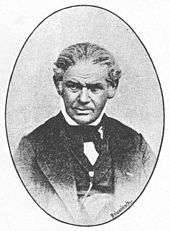Johann Mannhardt

Johann Michael Mannhardt (born August 31, 1798 in Bürstling near Gmund ; † August 25, 1878 in Munich ) was a German watchmaker , mechanic and inventor .
Life
Mannhardt was born in Bürstling am Tegernsee and initially worked as a goatherd. He learned the watchmaking trade in Gmund and developed a great talent for mechanical work at an early age. From 1821 he worked in Miesbach for the tower clock maker Fritz.
In 1826 he created the clock for the clock tower in Rottach-Egern . In 1833 he made the tower clock for the Protestant St. Matthew's Church in Munich . In 1844 he moved to Munich, where, among other things, he invented a new sealing machine and an oil mill as well as made the iron frames for the skylights on the roof of the Alte Pinakothek . He also improved a number of machines, including saws, lathes, and peat presses, and received several patents. Mannhardt continued to work as a watchmaker, in particular he created tower clocks for many European and American clock towers.
In 1844 he founded the Königlich Bayerische Hof-Thurmuhren-Fabrik Johann Mannhardt in Munich, which was taken over by the Ulmer Turmuhrenfabrik Philipp Hörz in 1928 .
Final resting place
Johann Mannhardt died in Munich in 1878. His grave is located in the old southern cemetery in Munich (wall on the right, place 185 at grave field 6, location ).
Honor
Streets in Munich and Miesbach are named after him.
plant
Various inventions and technical improvements in tower clock construction go back to Mannhardt , for example the Mannhardt pin escapement , a variation of the scissor escapement.
Well-known tower clocks:
- (undated): Clock tower of the parish church and the Portiunkula church in Miesbach
- 1833: Tower clock of the Protestant St. Matthew's Church on Sonnenstrasse in Munich (demolished by the National Socialists in 1938)
- 1826: St. Laurentius tower clock in Rottach-Egern
- 1842: Tower clock of the Frauenkirche in Munich, today in the Deutsches Museum
- 1880: Tower clock of Cologne Cathedral
- (undated): Tower clock of the Mülln elementary school in Salzburg , No. 1993
- (undated): Tower clock, Fürstenfeld Monastery
- (undated): Trinity church clock tower (Haunsheim)
Other works:
- With a guillotine made by the Johann Mannhardt company in Munich in 1854 for 1,000 guilders, the execution of the death penalty has been carried out since 1856. This guillotine - also known as the "Mannhardt guillotine" - consisted predominantly of iron. It was last in Munich's Stadelheim prison , where it was rebuilt by the last Bavarian executioner, Johann Reichhart, so that the executions could proceed more quickly. Due to the identical conversions, this example is very likely identical to the one that has been stored in the depots of the Bavarian National Museum since 1974 .
Individual evidence
- ↑ a b Richard Mühe: Old clocks. Callwey, Munich 1981, ISBN 3-7667-0576-8 , p. 303.
- ↑ Christian Schnurbus: The Mannhardt'sche Domuhr, their precursors and watchmakers . In: Kölner Domblatt . 83rd episode. Verlag Kölner Dom, Cologne 2018, ISBN 978-3-922442-94-3 , p. 129-165 .
literature
- GH Baillie: Watchmakers & Clockmakers of the World. Pomona Press, 2006, ISBN 1-4067-9113-X .
- Beni Eisenburg, Waldemar Rausch (ed.): Johann Baptist Mannhardt - a genius. In: Gmund books. Contributions to local history. No. 10. Ed. Heimatfreunde Gmund, Gmund 1998.
- Alexander Langheiter: Johann Michael Mannhardt. In: Miesbach. A cultural guide. Maurus, Miesbach 2006, ISBN 3-00-017020-0 .
- Lorenz Maier : Mannhardt, Johann Michael. In: Karl Bosl (ed.): Bosls Bavarian biography. Pustet, Regensburg 1983, ISBN 3-7917-0792-2 , p. 504 ( digitized version ).
- Hyacinth Holland : Mannhart, Johann . In: Allgemeine Deutsche Biographie (ADB). Volume 20, Duncker & Humblot, Leipzig 1884, pp. 200-203.
Web links
- Anita Kuisle : Mannhardt, Johann. In: New German Biography (NDB). Volume 16, Duncker & Humblot, Berlin 1990, ISBN 3-428-00197-4 , p. 64 f. ( Digitized version ).
| personal data | |
|---|---|
| SURNAME | Mannhardt, Johann |
| ALTERNATIVE NAMES | Mannhardt, Johann Michael (full name) |
| BRIEF DESCRIPTION | German watchmaker |
| DATE OF BIRTH | August 31, 1798 |
| PLACE OF BIRTH | Bürstling near Gmund |
| DATE OF DEATH | August 25, 1878 |
| Place of death | Munich |


